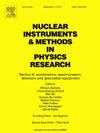The development of high-temperature heterogeneous catalysis sample environment equipment for neutron scattering at CSNS
IF 1.5
3区 物理与天体物理
Q3 INSTRUMENTS & INSTRUMENTATION
Nuclear Instruments & Methods in Physics Research Section A-accelerators Spectrometers Detectors and Associated Equipment
Pub Date : 2025-04-22
DOI:10.1016/j.nima.2025.170554
引用次数: 0
Abstract
The advancement of time-, space-, and energy-resolved in-situ characterization techniques utilizing neutron penetration and sensitivity to light elements has significantly improved our understanding of surface/interface structure-catalytic relationships in catalytic materials at atomic/molecular scales. The development of specialized sample environment equipment for catalysis is essential for enhancing in-situ characterization technology. In this study, we designed an in-situ neutron scattering sample environment capable of facilitating heterogeneous catalytic reactions (including gas-solid, liquid-solid, and gas-liquid-solid reactions) at 800 °C and 0.1 MPa. The system includes a gas-liquid controller, a catalytic reaction insert (CRI), a tail gas absorption cell, and a tail gas line. We evaluated the temperature and stress distribution during long-cycle operations through numerical simulations of the CRI, while the temperature calibration curve was established via offline testing, and background scattering measurements were obtained through online testing. We have completed the commissioning of the equipment, making it available for user operations.
CSNS中子散射高温非均相催化样品环境装置的研制
利用中子穿透和对轻元素的敏感性的时间、空间和能量分辨原位表征技术的进步,极大地提高了我们对催化材料在原子/分子尺度上的表面/界面结构-催化关系的理解。开发专用的催化样品环境设备是提高原位表征技术的必要条件。在本研究中,我们设计了一个能够促进非均相催化反应(包括气固、液固和气液固反应)的原位中子散射样品环境,温度为800℃,压力为0.1 MPa。该系统包括气液控制器、催化反应插入件(CRI)、尾气吸收池和尾气管路。通过对CRI进行数值模拟,评估了CRI在长周期运行过程中的温度和应力分布,并通过离线测试建立了温度校准曲线,通过在线测试获得了背景散射测量值。我们已经完成了设备的调试,可供用户操作。
本文章由计算机程序翻译,如有差异,请以英文原文为准。
求助全文
约1分钟内获得全文
求助全文
来源期刊
CiteScore
3.20
自引率
21.40%
发文量
787
审稿时长
1 months
期刊介绍:
Section A of Nuclear Instruments and Methods in Physics Research publishes papers on design, manufacturing and performance of scientific instruments with an emphasis on large scale facilities. This includes the development of particle accelerators, ion sources, beam transport systems and target arrangements as well as the use of secondary phenomena such as synchrotron radiation and free electron lasers. It also includes all types of instrumentation for the detection and spectrometry of radiations from high energy processes and nuclear decays, as well as instrumentation for experiments at nuclear reactors. Specialized electronics for nuclear and other types of spectrometry as well as computerization of measurements and control systems in this area also find their place in the A section.
Theoretical as well as experimental papers are accepted.

 求助内容:
求助内容: 应助结果提醒方式:
应助结果提醒方式:


